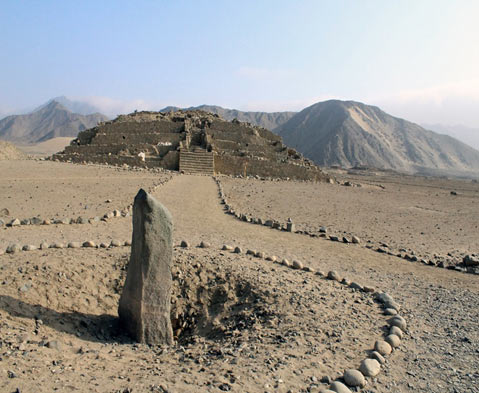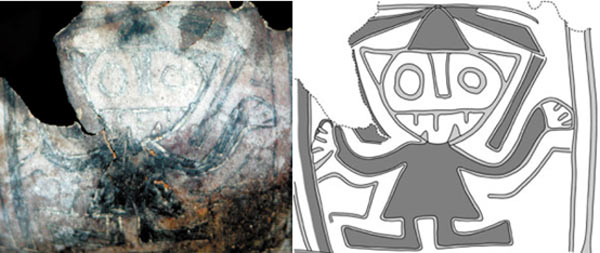
Unique artifacts shed light on daily life in 5,000-year-old city of Caral
(Read Part 1) The Sacred City of Caral is a 5,000-year-old metropolis which represents the oldest known civilization in the Americas, known as the Norte Chico. When it was first discovered, archaeologists had no idea of the extent of this great city, nor its age. It took some 90 years before researchers discovered its immense significance.
While the inhabitants of Caral lacked ceramics and limited art, they built huge monuments, including pyramids, plazas, amphitheatres, temples, and residential areas, had extensive agriculture, ate a varied diet, developed the use of textiles, used a complex system for calculating and recording, built water supply, and developed an intricate irrigation system. They traded widely with neighbouring societies, reaching at least as far as the Amazon jungle, as evidenced by carvings of monkeys.
Interestingly, no evidence of warfare has ever been found in Caral – no defensive structures, no weapons, and no bodies with violent injuries. Archaeologists believe the people of Caral were a peaceful culture who spent considerable time studying the heavens, practicing their religion and playing musical instruments.
The finely crafted flutes of Caral
One of the most surprising findings at Caral was the discovery of 32 flutes made of condor and pelican bones, and 37 cornets (musical instrument like a small trumpet) made of deer and llama bones. The musical instruments, which date to around 2,200 BC, were discovered in the exterior of a circular plaza of a pyramid complex, an area where hundreds of people could gather for community events.

A selection of the flutes found at Caral. Image source.
The instruments are decorated with engraved figures, including monkeys, supernatural birds that combine features of some other creatures such as felines or monkeys, bird-faced snakes, a double head comprising a bird and a snake, and two anthropomorphic figures. They were played by blowing into the central hole and covering either the left or right hand holes.
In 2001, researchers held the Archaeo-Musicological Research Workshop for the Flutes of Caral, in a bid to reproduce the sound of each one of them, just as the ancient dwellers might have heard them millennia ago.
The ancient mathematical and recording system of Caral
Another rare discovery that she light on the civilization found at Caral and in the Supe Valley was a segment of knotted strings known as a quipu. Quipus, sometimes called ‘talking knots’, were recording devices that consisted of coloured, spun, and plied thread or strings from llama or alpaca hair, or made of cotton cords. It is known that by the time of the Inca, the system aided in collecting data and keeping records, ranging from monitoring tax obligations, properly collecting census records, calendrical information, and military organization. The cords contained numeric and other values encoded by knots in a base ten positional system. Together, the type of wool, the colours, the knots and the joins held both statistical and narrative information that was once readable by several South American societies. In some villages, quipus were important items for the local community, and took on ritual rather than recording use.

The quipu found in Caral. Image source.
Until the discovery of the quipu in Caral, no other examples had been found that dated back earlier than 650 AD. So the significance of this finding was that it was now apparent that inhabitants of Andean South America were using this complex recording system thousands of years earlier than they initially thought.
Time-keeping in Caral – the Monolith Huanca
Across from the main staircase of one of the pyramids (platform mounds) in Caral is a solitary monolith known as ‘Huanca’ (the standing stone), which stands at 2.15 metres in height. Archaeologists believe that this monolith was used for astronomical and ceremonial purposes, and for determining the time of day. Measurements of the Huanca’s position in relation to the pyramids found that it sits exactly due north of one of the pyramids, known as ‘Huanca pyramid’. The angle of the stone to the top of the pyramid marks the of the summer and winter solstices .

The monolith Huanca in Caral. Image source.
Religion and spiritual beliefs
Very little is known about the religious beliefs and practices of the Norte Chico civilization which inhabited Caral. There is abundant evidence of drug use normally associated with Shamanism, which may provide some clues, but there is hardly any art in Caral, one of the key sources that archaeologists use to learn about the daily life and beliefs of ancient civilizations. Some scholars claim that the very few human remains found at Caral are sacrificial victims. However, in reality there is nothing to indicate that the individuals had been sacrificed as opposed to normal death.
There is one artefact that may serve to shed light on the beliefs of the Norte Chicos. Etched onto the side of a gourd (a hard seed pod used for carrying water), which dates to 2280-2180 BC, is a depiction of a sharp-toothed, hat-wearing figure who holds a long stick or rod in each hand, which has been named the Staff God.

Left: The Staff God on the side of the gourd. Credit: Jonathon Haas. Right: An outline showing the Staff God more clearly. Credit: Jill Seaguard
Interestingly, the same image of the Staff God appears on pottery urns of the Wari and Tiwanaku cultures dating from 1,000 BC, all the way through to 1,000 AD, and the deity is figured prominently on the Gateway of the Sun at Tiwanaku near Lake Titicaca. Could beliefs in a Staff God have begun with the Norte Chico civilization in Caral nearly 5,000 years ago and dispersed outwards to influence later civilizations?

Staff God on the Gateway of the Sun at Tiwanaku. It bears remarkable similarity to the deity depicted on the gourd found in Caral. Image source.
For an unknown reason, Caral was abandoned rapidly after a period of only 500 years. It is believed that climate changes forced the inhabitants to find a new location for their city, although where exactly they went is uncertain. However, the fact that the Staff God, and the use of the quipu is found some 2,000 years later in other locations throughout South America, suggests that the Norte Chicos took with them their rich culture, religion, technology, and practices, and came to influence some of the greatest civilizations followed over the next 4,000 years.
Featured image: The spectacular ancient site of Caral, Peru. Image source.
References:
Exploring the oldest civilization in the Americas – Goshen College
Oldest evidence of Andean religion found - Nature
Sacred City of Caral-Supe - UNESCO
Caral: the oldest town in the New World – Philip Coppens
Caral, the oldest city in America – Go2Peru
Caral: (Pyramid Complex) – Ancient-Wisdom
















Comments
This city certainly must have been one that was built by the Watchers when the fled the Levant upon their destruction in that area. It makes complete sense and fits the time period exactly as the Bible shows us in the Holy Scriptures.
These Watchers were able to bring up entire cities out of nowhere...there is no preceding culture. They had the technology, the geology, the math, and the entire knowledge of the solar and lunar processions which they used to form these types of cities and draw people in from all around to worship them as gods.
BBC has a documentary on Caral showing it changed theories about the origin of civilization since it disproved warfare was the reason for organizing into cities. This sacred, peaceful 1,000 years long city proved that the reason cities were develeped was trade. Another reason to be proud of Caral and being peruvian.
the image of "The monolith Huanca in Caral" immediately reminded me of the stones of Nabta Playa in Egypt. http://en.wikipedia.org/wiki/Nabta_Playa